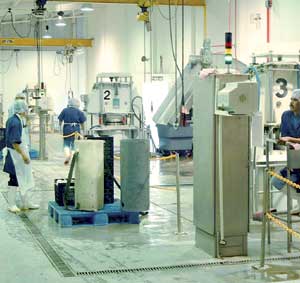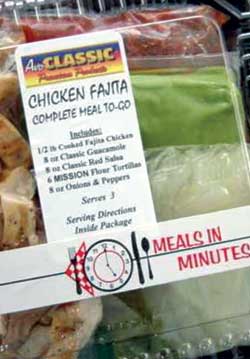

While the intent is admirable, the problem for food and beverage processors is judging which of those remedies will yield the biggest food-safety bang for the buck. Zero-tolerance policies would be fine if processors had unlimited budgets. Unfortunately, there are limits on what they can spend to advance food safety, so processors have to be become very savvy to avoid getting burned.
“The trend is to expect more and more in terms of safe food, and that’s not necessarily a bad thing,” observes Carl Winter, a food scientist at University of California-Davis and director of the FoodSafe program. “There are lots of legitimate issues being raised; they’re just not scientific issues. The scientific community is never going to be able to absolutely determine complete safety of a product under any condition.”
Fresh meats and ready-to-eat meat and poultry products are under intense safety scrutiny. Ratcheting up the heat is a new microbial sampling directive from USDA’s Food Safety Inspection Service to combat Listeria monocytogenes. The ubiquitous Listeria bacteria can survive extremes of heat and cold and has been found in everything from raw vegetables and soft cheeses to cooked poultry and smoked fish.
Post-processing contamination is often to blame when food safety is breached. In-package sterilization is the solution, and acceptance of that fact is opening the way for trial of technologies that accomplish that.
Resistance to irradiation is beginning to crumble. Many supermarket chains are rolling out irradiated beef products. Pathmark Stores in New York, New Jersey and Philadelphia began carrying irradiated ground beef chubs in PVC sleeves in October at a 20-cents-a-pound premium. “There probably is some trepidation about the technology, but we think the time is right,” according to Rich Savner, Pathmark’s director of public affairs. IBP is the supplier, with post-packaging irradiation handled at SureBeam Corp.’s Sioux City, Iowa, irradiation facility.
Brawley Beef LLC in California’s Imperial Valley is one of the few processors to evaluate in-line irradiation. The packer employs multiple food-safety interventions, including steam vacuuming, organic acid sprays, wash and rinse and thermal pasteurization, explains President Greg Beck, and ground beef irradiation will contribute to its objective of delivering “the safest beef products on the market.”
In-house pasteurization is the rule rather than the exception with ultra high pressure (UHP), and no commercial operator can match the processing capacity of Avomex Inc. in Keller, Texas. Beginning this month, Avomex will be applying some of that capacity to a line of ready-to-eat meals called Meals in Minutes. Everything except the tortillas in the refrigerated dinners are UHP processed in their packaging, including chicken and beef, guacamole, salsa, onions and peppers.
“We would never even consider putting out a chicken product with our guacamole without high pressure,” says Steve Parnell, Avomex’s president. “We work with the technology every day, so we have confidence we can produce a safe product with it.”
Avomex’s fresh guacamole has been UHP’s food-product poster child. Grocers’ initial reluctance to carry guacamole in a pouch gave way to requests for private-label versions as sales took off. Ownership invested in additional UHP units at Avomex and Juarez Foods, a sister company that operates a USDA-certified meat and poultry plant. The company now boasts 10 UHP units from Avure Technologies (formerly Flow), with a combined capacity for 1 million pounds of food per week.
“Guacamole and avocado have done great for us, but Meals in Minutes could potentially re-make our company,” says Parnell. The firm also is diversifying into fresh juice production, beginning with orange juice.
Chicken is processed at 87,000 psi, and “shelf life could easily go out six weeks,” he says. “But we’re more interested in safety and the organoleptic aspects of the meals.” Meals in Minutes have a 30-day freshness code.

Coat the world
Drains in food plants tend to be pathogen playgrounds, so the presence of Listeria in drains at Pilgrim’s Pride’s Franconia, Pa., facility was scarcely a revelation. The link between that strain and a Listeria outbreak in the Northeast led to a record recall of 27.4 million pounds of ready-to-eat deli products.Biofilms quickly form in drains to support thriving colonies of bacteria. Coating the drains with some sort of bactericide or antimicrobial compound could help alleviate the situation. David Howard, who heads a small equipment manufacturer called Unitherm Food Systems, decided to tackle the problem head on two years ago by specifying specially coated steel from Middletown, Ohio-based AK Steel for the drain traps he sells.
The steel is coated with a compound containing silver ion, a natural antimicrobial agent. The added protection only added $5 to his fabrication costs, Howard reports, an incidental amount that was not reflected in higher prices to end users.
AK Steel licenses the silver ion technology it uses from AgION Technologies, a Wakefield, Mass., firm. Medical device manufacturers are emerging as a prime market for the material, with a limited number of food equipment suppliers adopting the technology so far.
The technology relies on the controlled release of ionic silver to kill bacteria that come in contact with the surface. The material is safe for human contact—a French manufacturer coats catheters with the compound, and preliminary results suggest deep reductions in post-operative infections—but manufacturers are limited in the claims they can make in food applications.

One application of antimicrobial technology is the Dodge E-Z Kleen ball bearing housing. Introduced in 1998 by the power systems division of Rockwell Automation, the one-piece injection molded housing contains the proprietary antimicrobial UF-95 blended with the resin. After subjecting the housing to independent testing for its effectiveness in inhibiting bacteria and fungus growth, Kraft Foods standardized on the housing for its plants, according to Mark McElhinny, business manager for food & beverage at Rockwell’s Greenville, S.C., division.
The polymer housing is an added feature with the new Dodge Grip Tight Adapter ball bearing, an interchangeable housing design that lets manufacturers standardize all the ball bearings on their conveyors. The collar on the adapter attaches to the shaft for full concentric contact, reducing system vibration and providing greater wear resistance and quieter operation. More importantly, it dramatically reduces the number of inventoried spare parts, an efficiency with great appeal to end-users.
“With customers who are proactive about food safety, features like an anti-microbial housing give you modest differentiation with a commodity product like ball bearings,” says McElhinny, “but with Grip Tight, we’ve hit the sweet spot.”
DM-50 is the antimicrobial ingredient in seamless flooring and wall systems from Covington, Ky.-based General Polymers. Developed by Thomson Research Laboratories in Toronto, DM-50 constitutes 0.2 percent of surfaces’ composition, according to Tom Murphy, vice president of marketing. It can be formulated as an epoxy coating. Nursing homes often apply such a coating below carpeting to minimize odors from urine and other spills.
“We have to walk a fine line with these products in the food industry,” Murphy says, with bacteria-killing claims strictly taboo. But the products have become fairly standard in pharmaceuticals plants, where in-house testing has validated its effectiveness in combating bacteria and mold.
Poultry processor Wayne Farms was so impressed with tests involving Rexnord Corp.’s Triclosan-laced conveyor belting, safety director Randy Horwitz clamored for similarly treated products, including returnable tote trays from Orbis, boots and aprons from Wellington, hydraulic hoses from Goodyear and knives and blades from Victorinox.
“People are doing everything they can to keep their facilities clean and safe,” Rexnord’s Hans Anderson points out. “This gets you one-half step closer.”

High-pressure washdown environments such as meat plants are prone to recontamination after sanitation, and that is where antimicrobial conveyor belts can be a valuable safeguard. Anderson points out microbes can be encapsulated in water particles that become airborne. After the belt has been sanitized, the water can then settle back on the belt and recontaminate it.
Shuttleworth Inc. has introduced a conveyor treated with silver ion to inhibit growth of bacteria and mildew. The compound is formulated with acetyl and is incorporated in rollers as well as belting, according to Klaus Daenzer, senior plastics R&D engineer. As an additional food safeguard, the company offers AgION coating for a conveyor’s steel frame. DuPont bakes the antimicrobial powder onto prefabricated steel parts.
“We generally build conveyors for indirect contact with food,” says Daenzer, which limits the effectiveness of these belts in reducing the likelihood of cross-contamination. “We do not rule out belts for direct contact, if customers demand it,” he says. A treated belt on a beef fabrication line would do more to advance food safety than a similar belt that conveys packaged items or trays.
Some food-safety initiatives end up creating other problems for processors, as spring-water bottlers have discovered. Bromate is a naturally occurring compound in many springs, explains Rick Zahnow, industry sales manager at Pureflow Ultraviolet. Unfortunately, ozone treatments designed to disinfect the water tend to oxidize with the bromide to form bromate, a suspected carcinogen. A year ago, water bottlers had to begin complying with a limit of 10 parts per billion of bromate in their water, and ozonation pushed many bottlers in the South and in coastal areas above that threshold. “UV can reverse that reaction and disinfect,” says Zahnow, so some bottlers have installed UV units as a final treatment before filling.
“Wherever food or packaging is handled by air, there’s a high demand for UV units that go into compressed air lines,” he adds. In dairies, purified compressed air that is used to blow-mold HDPE containers and to convey bottle caps are helping processors add one or more days of shelf life to their milk products at minimal cost, Zahnow claims.
Calculating a payback from food-safety features can be difficult. Treated conveyor belts add about 15 percent to the cost, depending on the weight of the belt, estimates Rexnord’s Anderson. Assigning a dollar value to the additional safety it provides is virtually impossible, so food processors must rely on their own qualitative judgments of the value of treated versus untreated belts.
“The economics are going to be a big part of food safety interventions, along with the expectations of processors’ customers,” UC-Davis’ Winter points out. “There are no easy answers, and it will involve a wide range of options that don’t necessarily relate to standards such as HACCP.”
In the absence of cost-benefit analysis, food and beverage processors have to rely on qualitative assessments of the myriad processing options and antimicrobial products coming to market to help them satisfy their food-safety objectives.